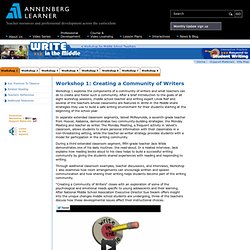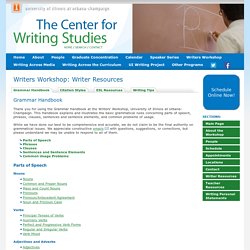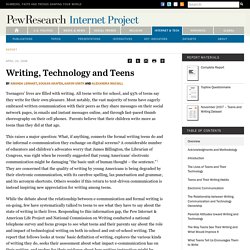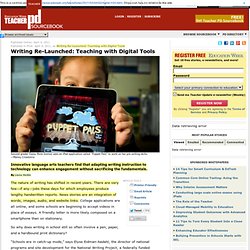

Secrets of Teaching Writing Revealed. The Art of Writing Little » Book. Multimedia Everywhere! - Digitizing the Writing Workshop. Teaching Writing with Technology. Building a story from a picture. Figurative Language. Research Building Blocks: “Organize This!” ReadWriteThink couldn't publish all of this great content without literacy experts to write and review for us.

If you've got lessons plans, activities, or other ideas you'd like to contribute, we'd love to hear from you. More Find the latest in professional publications, learn new techniques and strategies, and find out how you can connect with other literacy professionals. More Teacher Resources by Grade Your students can save their work with Student Interactives. More Home › Classroom Resources › Lesson Plans Lesson Plan Student Objectives Instruction & Activities Student Assessment/Reflections Students will create and use graphic organizers. work with students to brainstorm category labels. generate categories and subheadings. sort note cards into categories or subheadings. practice outlining skills. back to top Instruction & Activities The way in which the following example is used to “discover” outlines can be adapted to any research topic.
Research Topic: Beluga Whales Big questions/Categories: Write in the Middle: Program 1 - Creating a Community of Writers. Workshop 1 explores the components of a community of writers and what teachers can do to create and foster such a community.

After a brief introduction to the goals of all eight workshop sessions, middle school teacher and writing expert Linda Rief and several of the teachers whose classrooms are featured in Write in the Middle share strategies they use to build a safe writing environment for their students starting at the beginning of the school year. In separate extended classroom segments, Velvet McReynolds, a seventh-grade teacher from Hoover, Alabama, demonstrates two community-building strategies: the Monday Meeting and teacher as writer.
The Monday Meeting, a frequent activity in Velvet's classroom, allows students to share personal information with their classmates in a non-threatening setting, while the teacher-as-writer strategy provides students with a model for participation in the writing community. A public dialogue about belief — one essay at a time. Grammar Handbook « Writers Workshop: Writer Resources « The Center for Writing Studies, Illinois. Thank you for using the Grammar Handbook at the Writers' Workshop, University of Illinois at Urbana-Champaign.

This Handbook explains and illustrates the basic grammatical rules concerning parts of speech, phrases, clauses, sentences and sentence elements, and common problems of usage. While we have done our best to be comprehensive and accurate, we do not claim to be the final authority on grammatical issues. We appreciate constructive emails with questions, suggestions, or corrections, but please understand we may be unable to respond to all of them. Handbook Sections Parts of Speech Nouns Verbs Adjectives and Adverbs Conjunctions Other Parts of Speech Phrases Clauses Sentences and Sentence Elements Common Usage Problems. Summary of Findings. Teenagers’ lives are filled with writing.

All teens write for school, and 93% of teens say they write for their own pleasure. Most notably, the vast majority of teens have eagerly embraced written communication with their peers as they share messages on their social network pages, in emails and instant messages online, and through fast-paced thumb choreography on their cell phones. Parents believe that their children write more as teens than they did at that age. This raises a major question: What, if anything, connects the formal writing teens do and the informal e-communication they exchange on digital screens? A considerable number of educators and children’s advocates worry that James Billington, the Librarian of Congress, was right when he recently suggested that young Americans’ electronic communication might be damaging “the basic unit of human thought – the sentence.”
At the core, the digital age presents a paradox. Education Week Teacher Professional Development Sourcebook: Writing Re-Launched: Teaching with Digital Tools. Published Online: April 4, 2011 Published in Print: April 4, 2011, as Writing Re-Launched: Teaching with Digital Tools Second grader Daisy Mora Gomez uses an iPad application called "Puppet Pals" to work on her pre-writing skills.

—Manny Crisotomo Innovative language arts teachers find that adapting writing instruction to technology can enhance engagement without sacrificing the fundamentals. The nature of writing has shifted in recent years. So why does writing in school still so often involve a pen, paper, and a hardbound print dictionary? “Schools are in catch-up mode,” says Elyse Eidman-Aadahl, the director of national programs and site development for the National Writing Project, a federally funded program that provides professional development in writing instruction.